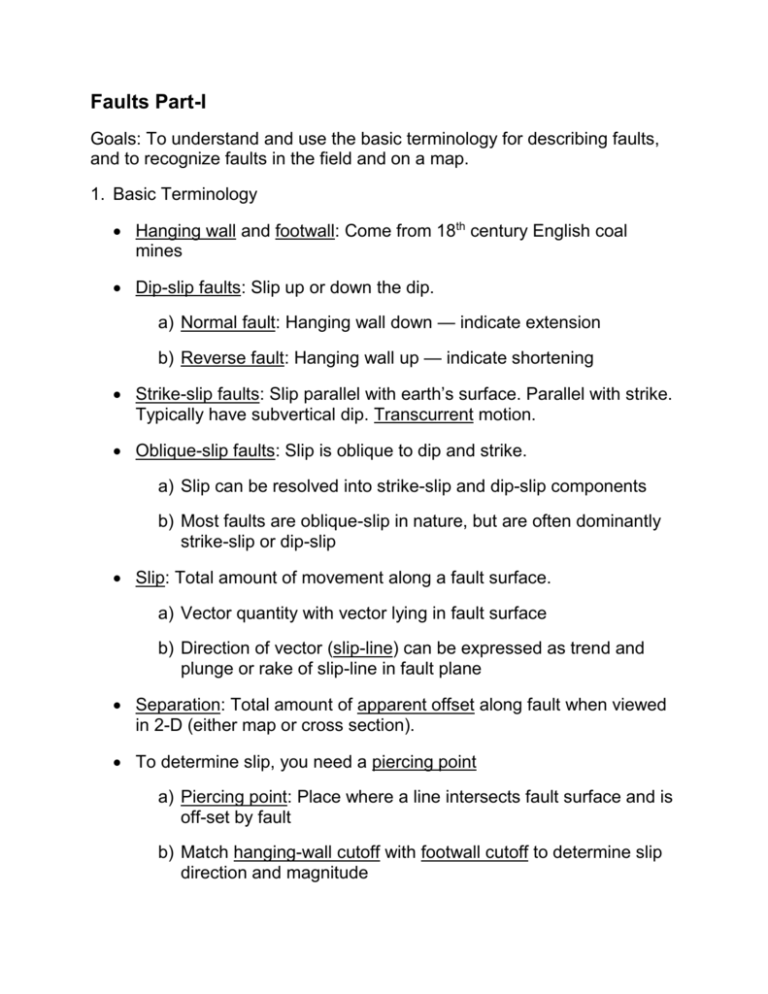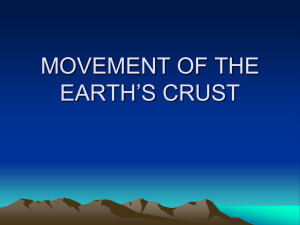Faults Part-I
advertisement

Faults Part-I Goals: To understand and use the basic terminology for describing faults, and to recognize faults in the field and on a map. 1. Basic Terminology Hanging wall and footwall: Come from 18th century English coal mines Dip-slip faults: Slip up or down the dip. a) Normal fault: Hanging wall down — indicate extension b) Reverse fault: Hanging wall up — indicate shortening Strike-slip faults: Slip parallel with earth’s surface. Parallel with strike. Typically have subvertical dip. Transcurrent motion. Oblique-slip faults: Slip is oblique to dip and strike. a) Slip can be resolved into strike-slip and dip-slip components b) Most faults are oblique-slip in nature, but are often dominantly strike-slip or dip-slip Slip: Total amount of movement along a fault surface. a) Vector quantity with vector lying in fault surface b) Direction of vector (slip-line) can be expressed as trend and plunge or rake of slip-line in fault plane Separation: Total amount of apparent offset along fault when viewed in 2-D (either map or cross section). To determine slip, you need a piercing point a) Piercing point: Place where a line intersects fault surface and is off-set by fault b) Match hanging-wall cutoff with footwall cutoff to determine slip direction and magnitude Slip direction can also be determined by measuring slickenlines Character of faults a) Discrete, single plane b) Zone of anastomosing, closely spaced faults (fault zone) c) Wide zone of penetrative, plastic deformation 2. Fault rocks: Two main categories, frictional/brittle and plastic Frictional/brittle fault rocks: Record mechanical disaggregation and “grinding” of original rocks. a) Fault gouge: Clay-sized particles ground from original rocks on either side of fault. b) Fault breccia: Angular chunks of protolith from either side of fault surrounded by gouge and/or vein material precipitated from solution. c) Cataclasite: Indurated version of fault gouge. Forms deeper in the crust. d) Pseudotachylyte: Glass formed from frictionally generated melt at fault surface. Plastic fault rocks: Record plastic flow of minerals at the molecular scale in response to differential stress. Deformation is “penetrative” and commonly results in grain-size reduction due to deformationdriven (dynamic) recrystallization. a) Protomylonite: Up to 10% dynamically recrystallized material b) Mylonite: 10–90% dynamically recrystallized material c) Ultramylonite: 90–100% dynamically recrystallized material 3. Recognizing faults in the field and on maps Truncation of rock units Visible off-set of rock units Omitted or repeated stratigraphy or biostratigraphy Juxtaposition of seemingly unrelated rock units










